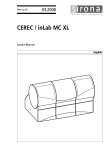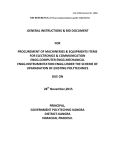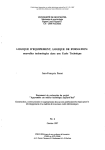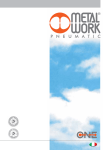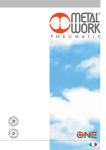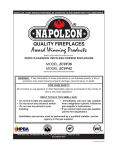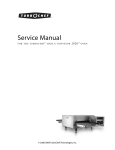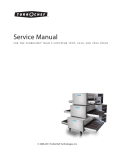Download Spillage conveyor Operating instructions
Transcript
Spillage conveyor Operating instructions Operating instruction Spillage conveyor 1 Contents Contents 1 Contents_____________________________________________________ 1-1 2 Data_________________________________________________________ 2-1 2.1 3 4 Apparatus and motor list _______________________________________ 3-1 3.1 Apparatus list ____________________________________________________3-1 3.2 Motorlist ________________________________________________________3-2 Function description ___________________________________________ 4-1 4.1 5 6 7 Spillage conveyor _________________________________________________4-1 Operation ____________________________________________________ 5-1 5.1 Start ___________________________________________________________5-1 5.2 Stop ___________________________________________________________5-1 5.3 Surveillance _____________________________________________________5-2 Interference and fault search ____________________________________ 6-1 6.1 Fault search _____________________________________________________6-1 6.2 Alarms _________________________________________________________6-1 6.3 Measures at alarm ________________________________________________6-1 Safety _______________________________________________________ 7-1 7.1 8 Pos 1 __________________________________________________________2-1 Safety directions __________________________________________________7-1 Safety declaration _____________________________________________ 8-1 Version 2 1-1 Operating instruction Spillage conveyor 2 Data Data 2.1 Pos 1 Main data Inside width mm Speed m/s Length mm Installed effect kW 0,12 2,2 Transmission BTM 32 W Motor 112M6 Bearing unit drive section SKF FY 50 TG Bearing unit tensioning section SKF FY 50 TG Execution Design type BruniTec System 2000 No of sections pcs Chain type Length mm Chain wheels type 74 Sy Spec z=8 Flights type Brunitec 8.0105-283 VST L= Chain support type Oak 80x38 8.0105-282 Version 2 Ewert no 74 distance 2500 2-1 Version 2 101 102 103 104 105 106 107 108 109 110 111 112 113 114 115 116 117 118 Conveyor no Name Apparatus and motor list 3.1Apparatus list 3 Description Spillage conveyor I/O signal Operating instruction A V 3-1 Notes Apparatus and motor list Version 2 101 102 103 104 105 106 107 108 109 110 111 112 113 114 115 116 117 118 119 Conveyor no 3.2 Motorlist Name IEC Effect kW Started current A Spillage conveyor Operating instruction Current V output rpm 3-2 Notes Apparatus and motor list Operating instruction Spillage conveyor 4 Function description Function description 4.1 Spillage conveyor The conveyor collect carry-back material from a beltconveyor. Material is normally reintroduced to the flow by unloading the spillage conveyor to the discharge chute of the beltconveyor. The conveyor has two parallel chains with flights in between mounted with 2.500 mm spacing. The flight is welded to two chain links. The chains are sliding on sturdy supports made of oak which are bolted to the conveyor sides. 4.1.1 4.1.1.1 4.1.2 4.1.2.1 4.1.3 Safety By inspection and work on and beside the spillage conveyor, the instructions in chapter 7 Safety shall be followed. Emergency stop The spillage conveyor shall be interlocked to the belt conveyor emergency stop function. Equipment Tensioning device The spillage conveyor has a tensioning device integrated in the tensioning section. The chains are tensioned by screw tensioner. Both sides can be tensioned from one side if the accessories one-sided tensioner is used. Control 4.1.3.1 Timer The spillage conveyor shall be operated intermittent to minimize wear. The interval between each operation period shall be modified to handle the amount of spilled material. The operation is normally controlled by a timer function in the plant control system. The spillage conveyor shall be interlocked with the belt conveyor that it is installed on. If for example installed where there is freezing problems at wintertime it is recommended to decrease the intervals to avoid problems. 4.1.3.2 Speed monitor It is recommended to use a speed monitor on the tensioning shaft to indicate that the conveyor is running. Difference against nominal value shall result in immediate stop of the conveyor and alarm to operator. Version 2 4-1 Operating instruction Spillage conveyor 5 5.1 Operation Operation Start Start of conveyor is normally controlled from the main control system and operator. 5.1.1 Preparations before start Instructions according to chapter 7 Safety shall be followed. Before automatic start of the conveyor it should be tested manually under surveillance. 5.1.2 Start after shorter stop Short stop is less than 2 days. Instructions in chapter 7 Safety shall be followed. 5.1.3 Start after longer stop Longer stop is more than 2 days. Instructions in chapter 7 Safety shall be followed. The instructions under 5.1.1Preparations before start shall be followed before taken into operation again. 5.1.4 Check after start See 5.3.1Surveillance during operation 5.2 Stop 5.2.1 Short stop Short stop is less than 2 days. The conveyor shall be emptied before stop. 5.2.2 Long stop Long stop is more than 2 days. At a long stop the conveyor shall emptied, cleaned and inspected. The conveyors safety switch shall be switched off. Version 2 5-1 Operating instruction Spillage conveyor 5.3 Operation Surveillance 5.3.1 Surveillance during operation The condition for an economical operation is that the instructions and intervals regarding inspections and maintenance is followed and thoroughly performed. This is also an assumption for a long life of the equipment. The inspections shall be repeated sufficiently often during the period of operation. The proposed intervals is only recommendations. Experience from the operation can show that the intervals needs to be modified. During longer planned stops the conveyor status shall be checked regarding wear, corrosion, damages etc. 5.3.1.1 Check list Check the spillage conveyor regarding: • • • • • • • accumulated material noise heat oil leakage motor, cooling fan working and not clogged bolt joints Check the running time. The interval between every running period shall be adjusted to correspond with the amount of spillage from the belt conveyor. • Check the chain tension. Check especially that the tension is the same on both sides and that the chain slack on the upper part at the drive station is no more than 25-30 mm. • Check the flights and chain supports. • Check the function of the speed monitor. Inspection interval: 7 days Version 2 5-2 Operating instruction Spillage conveyor 6 6.1 Interferences and fault search Fault search 6.1.1 6.2 Interferences and fault search Spillage conveyor See maintenance instructions Alarms Example of alarms that can occur: • • 6.3 emergency stop speed monitor alarm Measures at alarm Depending of where the fault has occurred, part of or the whole system can stop. The operator have to decide from time to time which measures that have to be taken. At fault search it shall not be excluded that the fault can depend on a switch or monitor itself or at it’s connection to the control system. The fault can also be found in the control system. 6.3.1 Emergency stop 1 Identify which emergency switch that has been activated. 2 Check if any person has been harmed. 3 Find out the cause. 4 Limit the damages as best as possible. 5 Correct the fault. 6 Reset the emergency stop. 7 Run the conveyor manually and check the function. 8 Start the conveyor in automatic mode. 6.3.2 General instruction for fault search 1 Identify from where the alarm has been activated. 2 Find out the cause for the alarm. 3 Correct the fault 4 Run the conveyor manually and check the function. 5 Start the conveyor in automatic mode. Version 2 6-1 Operating instruction Spillage conveyor 7 Safety Safety Before the conveyor is taken into operation the first time, the installation including electrical installations, connections to the control system and programming be declared to be in provision with the applicable EEC regulations and directives regarding safety. It is an assumption that the power supply to the conveyor motor is interlocked to the emergency switches for the belt conveyor. 7.1 Safety directions To keep the safety on an accepted level, these instructions have to be followed. Emergency stop switches, contact protection or other safety devices shall under no circumstances be disconnected or in other ways taken out of operation. 7.1.1 Before start Following points shall be checked before start: • • assure that no person is inside or close to the conveyor assure that no foreign objects or material is inside or in risk to fall into the conveyor • all protection and safety devices shall be mounted and activated 7.1.2 Emergency stop Find out where the emergency stops are located. 7.1.3 Service or adjustments on spillage conveyor Machines controlled by automatic control system can start without warning. By service or adjustment on the conveyor, the safety switch shall be switched off and locked. 7.1.4 Electrical installations No works is allowed during operation. Changes in the electrical installations shall only be performed by certified personal. 7.1.5 Version 2 Petroleum products Repeated contact with petroleum products can cause permanent skin problems. 7-1 Operating instruction Spillage conveyor 7.1.6 Safety Instructions and signs Instructions, directives and rules regarding safety and environment have to be followed. Respect signs on and around machinery and installations. 7.1.7 Personal safety Do not use loose hanging clothes which can get jammed in moving machinery. Always use ear protection in noisy environment. Always use breathing protection in dusty environment Version 2 7-2 Operating instruction Spillage conveyor 8 Safety declaration Safety declaration DECLARATION OF CONFORMITY We, Brunitec Engineering AB, Box 48, 23521 VELLINGE, SWEDEN declare under our sole responsibility that the product Brunitec® Spillage conveyor to which this declaration relates is under the conformity with the provisions of the Directives including additions and revisions • 89/392/EEC (machinery) • 89/336/EEC (electromagnetic compability) • 73/23/EEC (electrical equipment designed for use within certain voltage limits) but must not be put into service until the equipment which it is to be incorporated into or assembled with has been declared in conformity with the provisions of applicable EEC Directives Vellinge 2001-10-04 ........................................................... Ove Brunius MD Version 2 8-1












